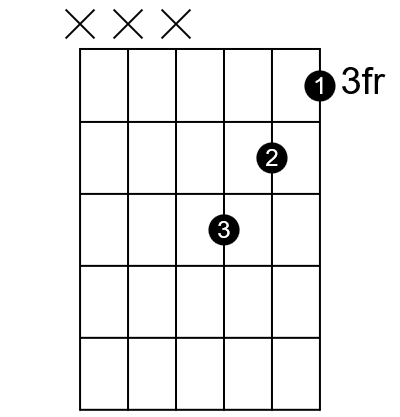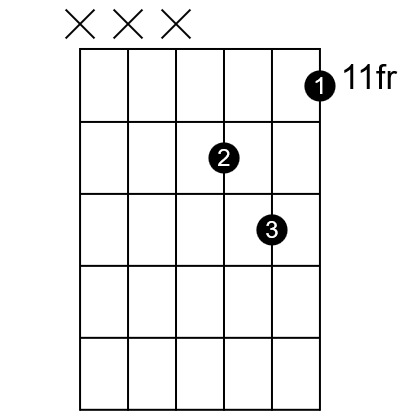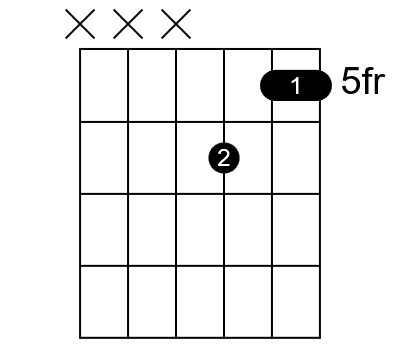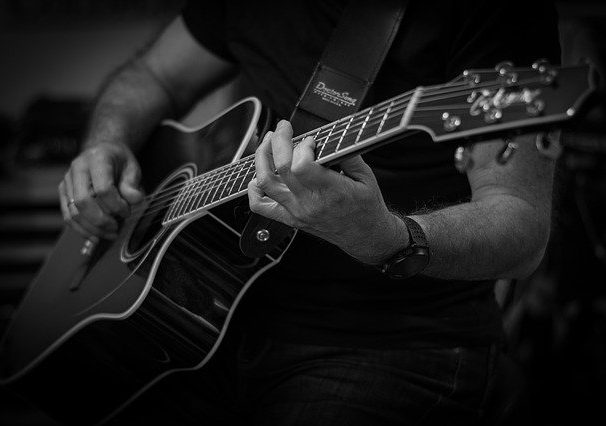Just like the minor scale adds a different feel to your music, you can use minor triads to add a new dimension of emotion to your playing. You can use minor triads in much the same way that you use major triads. When you add them to your playing, you can set up moody or sad feelings that bring a different set of emotions to your listeners.

What is a minor triad?
In music, a minor triad is a three-note chord made up of the root note, the flatted third note, and the fifth note of the major scale. Looked at another way, a minor triad is made up of the first, third, and fifth degrees of the minor scale. The flatted third note gives the chord its minor tonality. Minor triads are characterized by a more sad, moody sound than their major counterparts. There are three possible inversions of any minor triad.
You can consider minor triads as simplified versions of more complex minor chord shapes. But they are complete chords on their own, and serve an important function in all kinds of playing situations.
How do you make minor triads?
As mentioned above, to make a minor triad, you need to find any combination of the 1, the flatted 3, and the 5 of the major scale. As with major triads, all of the notes of the triad must be within one octave of each other.
You can find these combinations all up and down the neck. They also exist across different sets of three strings. To make these chords, you just need to know the shapes and which frets to play them on.
For this discussion, we’ll concentrate only on the thinnest three strings. In future articles we can discuss minor triads that exist on other sets of three strings.
Three inversions of minor triads
Just as with major triads, minor triads have inversions, so you can make the same minor triad with three different shapes. Let’s take a look at each of these shapes on the G, B, and High E strings.
Haven’t learned about major triads yet?
The root position minor triad
In a root position minor triad, the three notes of the chord appear in order from the lowest note to the highest. So, in the root position minor third you have the 1, 3b, and 5 scale degrees in order. The root note is the lowest note of the chord.
Let’s use a C minor triad as an example. To make a C minor triad you need a C (the root note), an Eb (the flatted 3rd) and a G (the 5th).

In the root position minor triad, the C note will be the lowest note, so we’ll have to find it on the G string (the lowest of the three strings we’re using in our examples). Press fret 5 of the G string with your ring finger to make the C note.
The Eb sits at fret 4 of the B string. Use your middle finger to play that note.
Finally, press the G note at fret 3 of the High E string with your pointer.
You’ll find this a very comfortable chord shape to play. You can get to it quickly and it’s easy to play the notes cleanly. For those reasons, this is a wonderful triad to work into your playing.
The first inversion minor triad
In the first inversion, the notes of the chord are ordered 3b, 5, 1. So for the first-inversion C minor triad we’ll have Eb, G, C.

This shape is even easier than the root-position shape. All three of the notes exist on the same fret. To play them, you bar across all three strings with your pointer finger.
So, for a C minor triad, bar the G, B, and E strings at the 9th fret.
This is also the easiest inversion to locate on the fretboard since the 1 note sits on the E string. If you know the notes on the E string as well as you should, then you can get to this chord instantly.
This shape is even cooler because it consists of three notes of Box 1 of the minor pentatonic sale. This makes it very easy to play the chord and throw in a few minor pentatonic lead riffs while you’re there.
Need to learn the notes on the E string?
How to easily learn the notes on the E string
Don’t have the minor pentatonic scale mastered?
The second inversion minor triad
The notes in the second inversion minor triad appear in the order 5, 1, 3b. In a C minor triad, those notes are G, C, Eb.

To play this inversion, we need to find the G note on the G string. We won’t have room to play this chord shape with the open G string, so you’ll have to go to fret 12 to play one octave higher. Press the G at fret 12 of the G string with your middle finger.
Next play the C at fret 13 of the B string with your ring finger. And complete the shape with your pointer at fret 11 of the E string for the Eb.
While this is not necessarily a complicated shape to play, it can be the most difficult of the three shapes to locate quickly. Unless you know the notes of the B string very well, you might struggle to work out where the root note is and build the chord around it.
The solution? Learn the notes of the B string!
What’s the difference between minor triads and major triads?
The technical answer hinges upon the third degree note in these chords. Recall from the article linked above that a major triad consists of the 1st, 3rd, and 5th scale degree notes of the major scale.
As you’ve learned in this article, minor triads consist of the 1st, flatted 3rd, and 5th scale degree notes of the major scale. So you don’t have to look too closely to notice how similar the two triads really are. In fact, that third degree marks the only difference between major and minor.
And as I talked about when I discussed the minor scale, it’s that flatted third that totally identifies a minor scale. It’s also that flatted third that identifies minor triads.
Need to learn about the minor scale?
To make the similarity between these two triads, let’s compare the shapes of one major triad with its corresponding minor triad.

The E-shape major triad
The E-shaped major triad is the first inversion of the major triad on the top three strings. Remember, this means that the 3rd is the lowest note and sits on the G string. The root is the highest note which you find on the High E string.
In this diagram, pay special attention to the 3rd. In the A major triad shown here, the third is a C#. That’s the note that defines the chord as a major chord.

The E-shaped minor triad
Just like its major counterpart, the minor triad is the first inversion when you play it on the top three strings. Again, you find the 3rd on the G string and the root on the High E string.
In fact, as you can see when you compare the diagrams, the 5th and the root remain exactly the same as the major triad. Only the 3rd differs. You can see that the third has dropped by one fret. In other words, the 3rd has been flatted.
Comparing these two images can really help cement the technical difference between a major chord and its minor counterpart. The visual image of flatting one note really drives home the purpose of the 3rd as opposed to the flatted 3rd.
It’s this flatted 3rd that defines the difference between a major chord and its minor counterpart.
What’s the musical difference between a major and minor triad?
While the charts above make the structural difference between the two triads quite clear, they don’t explain the difference in terms of the emotion of music. And that’s the really important point to take away.
Like the minor scale compared to the major scale, the minor triad compared to the major triad sounds more moody. It probably sounds more sad to you.
Songs that use minor keys have minor chords as their main chords. Thus, in a minor key song, the minor triads you play are typically more prominent than any major chords you might play in the song. Because of this, the song has a more melancholy feel compared to a major-key song. Of course, we’re speaking in generalities here, but this holds by and large.
As a songwriter, if you want a song that sounds more sad, then you might want to write it in a minor key. And you might want to use minor triads prominently.
If you’re a performer and you’re trying to find music that fits a more melancholy mood, reach for a song in a minor key.
When do you use minor triads?
You can use minor triads in many many situations. As I said above, if a song is written in a minor key, then you have all kinds of opportunity to use minor triads.
You might replace an open minor chord with a minor triad. As a lead guitarist, you might incorporate minor triads as chord stabs that accentuate certain beats of each measure. Or you might use minor triads as a base for a lead solo.
What is a chord stab?
A chord stab is a short, quick chord that accentuates certain important points in a measure of a song. The abrupt attack of the chord and its short duration account for the name “stab” and give the chord a percussive quality. For instance, lead guitarists commonly hit a chord with an aggressive strum but deaden the strings almost immediately so that the chord does not continue to ring out. They might do this on the second and fourth beat of a measure to emulate or accentuate the beat of a snare drum.
But you’re not limited to using minor triads only in minor-key songs. Many songs written in major keys also include minor chords in their progression. If you’re playing a song like that, you might use a minor triad instead of a full minor chord.
There are endless opportunities to use minor triads in many songs and pretty much any genre of music.
Why are minor triads important?
Many of the things that make major triads important also apply to minor triads. You can use them to add new dimensions to your guitar playing. They enable you to play chords in several different areas of the neck.
They also make it possible for you to technically stay on a single chord for many measures, yet still build interest into your playing.
For instance, say the song calls for an A minor chord for four measures. You could play the open A minor for one measure and switch to the root position minor triad for the second measure. Then you could play the first inversion for measure three and the second inversion for measure four.
If you do this, you’ll find that you’re moving all around the neck to find the same chord. But you’re using different shapes and different inversions. All of that adds a lot of movement and interest to your playing.
They also serve as important tools for lead guitarists, as I already mentioned. Minor triads really open up the neck and create many playing possibilities and many chances for playing more interesting guitar parts.
Are minor triads or major triads more useful?
You can’t consider either more important than the other. They both play their parts. And they both open the door for so many possibilities for interesting guitar playing.
You might be able to argue that major triads hold more importance in major-key songs and minor triads in minor-key songs. But while that’s probably true, both types can often be used in both types of keys. It just depends upon what the chord progression calls for.
In the end, it’s sort of a meaningless question. Triads of all types are massively important. Especially to players who want to introduce different sounds into their playing.
Conclusion
Minor triads serve much the same purpose as their major counterparts. They give you tools to play the same chords in three different inversions to add interest to your playing.
They also enable you to move up and down the guitar neck and access different parts of your instrument.
Minor triads are identical to their corresponding major triads except for the flatted 3rd note. It’s that note that identifies a triad as a minor triad. Just as with major triads, minor triads play an extremely important roll for both rhythm guitarists and lead guitarists.
Incorporate minor triads into your playing and see how you can make your guitar parts more interesting, exciting, and intriguing.
